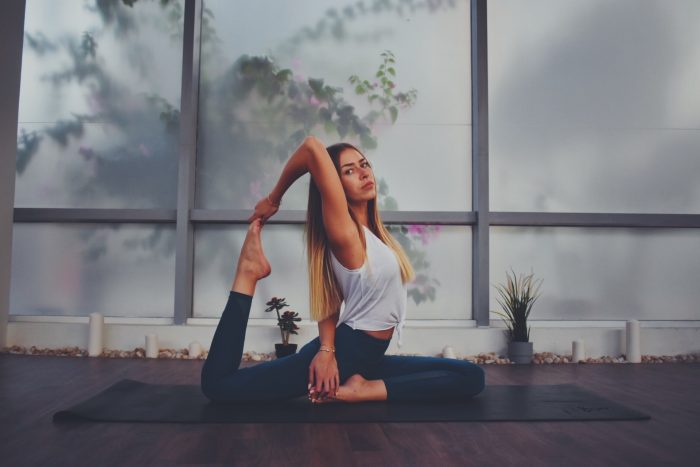In my mid-20s, I was the queen of escapism.
The second I was alone, and all the dark thoughts I had suppressed about myself started to seep through the cracks of my sobering, I had many tactics to find that ever-elusive friend—happiness.
When guilt plummeted my stomach like heavy stones at 3 a.m.? A nighttime cigarette under the stars, what kind companions. Insecure? Another shot of whiskey. When I wanted to feel free? Ecstasy. Wanted to feel sharp, intelligent, and invincible instead of the typical pathetic, unworthy person I was? Another bump in the bathroom. Scared of dying alone? Allow his eyes to linger tonight. Want to find the universe or god? Acid will launch one to the heavens. Anything—as long as I didn’t have to sit with myself.
Shopping, movie marathons, schedules, dates, plans, meetings—being busy—is how we escape from the clutches of our reality. It’s like dancing on the edge of a cliff while assuming it’s safe to twirl like wild—eventually, we fall into the depths of what we are trying to avoid. We plummet to the depths of this metaphorical canyon; it kinda looks like collapsing on the floor of our laundry room, black mascara marks streaking down our face, crying over a broken zipper in quells of grief that our questioning neighbors on the other side of our thin apartment wall just don’t quite understand.
Sometimes, our yoga practice takes the form of escapism, of running away from ourselves.
We become obsessed with the physical portion of the practice, choosing hot rooms and speedy flows to allow us to crumple on our backs in exhaustion and fool ourselves into thinking it’s peace.
During practice, we adjust our shirts, fix our hair, wonder what band is playing, pick our nails—all to avoid what might be lingering in the spaces between our thoughts.
I used to think an advanced yoga practitioner was someone who could twist their body into deep shapes or stand firmly on their hands, graceful upside-down.
Now, I know better.
Now, I see advancement on the spiritual path as someone who moves eloquently slow, sentient, completely aware. They don’t fidget in stillness, but rather remain steadfast and calm.
They know how much is to be marveled at in stillness; they know not to follow the fluctuations of their mind. They are someone no longer shackled to their emotions, explosive in their reactions, they remain steady in life: present, human, yet, somehow, incandescent.
Our yoga mats are not where we turn to escape life, like a numbing glass of wine. It is where we go to feel it fully, to sit with pain, to learn about our mind’s habits, to witness our beliefs. It is where we turn the mirror on ourselves and learn where we are impatient, where we are kind, where we judge.
Yoga isn’t a place to escape the turmoil of our relationships, to run from our mind, an argument with our boss, or anything else—it’s where we land to face life head-on.
Yoga, or asana as it’s typically experienced in a studio, seems a new rampant form of escapism. I know, because I’ve been teaching for eight years and I can arrogantly say I’ve seen it in many of my students, but also, I can’t be so vain to claim that I am innocent.
Yoga is more than asana, physical movement. I will not dismiss the power of moving our bodies to shift prana; to build strength is to cultivate the soil of our mind so our thoughts can grow steadfast, true.
The “vinyasa” sequence we are so obsessed with is not an ancient practice of Indian culture to “salute the sun,” but rather the adaptation of foundational British gymnastics, a creation spurred by globalism and putting India on the world’s stage.
So, what asana we do is unimportant; what is more is the other seven steps, limbs, or layers: introspection, meditation, breath, sense withdrawal. I daresay, yoga can be practiced as we walk, as we run, anything that stills our minds and helps us catch glimpses of the luminous being within. Pranayama, breathwork, is what will transform us, the grueling work of unconformability on our mat.
Sitting with our mind, as it screams it’s bored, is where we will cultivate self-knowledge, self-love, patience, humility, and obtain a more radiant life.
In case we forget why we show up on our yoga mat (for stillness, inner work, practice), here are some inspiring quotes from Pandit Rajmani Tigunait in his book The Secret of the Yoga Sutra: Samadhi Pada to remind us:
“Attachment to the notion of a god outside you is a curse. You must overcome it. Rediscover your luminous Self and embrace it wholeheartedly.”
“Yoga is an experiential path, and experience comes from practice. Practice is the key to success, for practice leads to a direct experience of our inherent grandeur.”
“When directed outward, the mind unveils the mysteries pertaining to the external world: we become scientists. When directed inward, it unveils its own mysteries and sees the Seer within: we become sages.”
“Yoga practice (sadhana) is the means for awakening the dormant potentials of our mind, experiencing our inner divinity, and becoming established in our essential nature.”
“Our core is Pure Consciousness; luminosity is our essential nature.”
“The key to discovering the full scope of our excellence lies in understanding our mind and attaining mastery over it. The mind is the greatest of all mysteries. A clear, calm, one-pointed, friendly mind puts all the treasures of the world at our disposal. But a mind that has become dense, agitated, scattered, confused, and unfriendly robs us of our most fundamental privilege—our indomitable will to excel and achieve what only humans have the capacity to achieve. Unveiling the mystery of the mind is the core of Yoga philosophy and practice.”
~









Read 7 comments and reply